
How to Check for and Prevent Snowmobile Track Damage
A key component of your pre-ride inspection is checking your track for damage. Operating with a damaged track increases the possibility of track failure, which could cause loss of control, resulting in serious injury or death. Always inspect the track before riding.
The following will help you recognize common forms of track damage, learn the causes of that damage and know how to prevent different types of damage to your track. For assistance with damaged tracks, contact a participating RideReady dealer.
Track Damage

Description: The track lug is damaged, cut or worn.
Cause: Track overheats by running at high speeds or on hard pack snow. Track damaged by spinning on rocks, stumps or other hard objects.
Recommendations: Avoid spinning your track on low or no-snow conditions. Do not run at high speeds over long distances or extended periods of time. This is especially important in conditions with minimal cooling and lubrication or when operating a track with a 1-inch or higher profile.
Clip Damage

Description: Track clips can appear to have a blue tint. Rail sliders build up on the clips.
Cause: Track spinning on gravel, pavement, ice or hard surfaces. Track is run at high speeds over long distances or extended periods of time. Lack of lubrication or cooling on slides and clips.
Recommendations: Avoid running in conditions with minimal snow or hard surfaces for extended periods of time.
Stud Damage
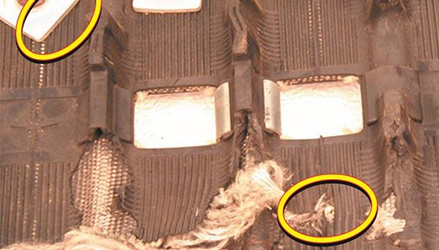
Description: Traction products have been added to increase traction.
Causes: Incorrectly placed traction product installed on the track (traction product not placed in the center of the outside belt of the track). Incorrect size of traction product installed on track. Incorrect traction product backing plate orientation, causing backing plate to cut into the track.
Recommendations: Frequently check traction products for correct mounting.
Impact Damage
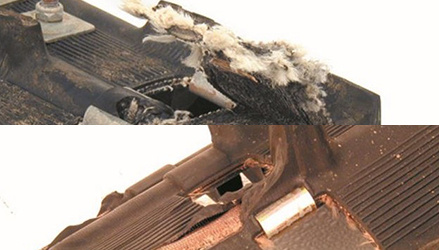
Description: Track cords are frayed and showing, sometimes exposing the rod.
Cause: Track damaged by rocks, stumps or hitting hard objects.
Recommendations: Avoid riding in conditions with minimal snow or hard surfaces and objects.
Suspension Damage
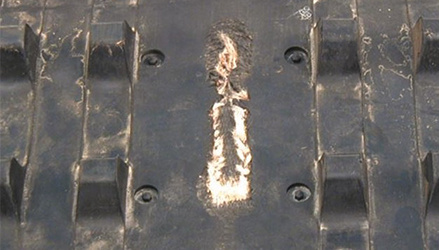
Description: Excessive wear and/or damage on the inside of the track or on the drive lugs. A dull finish usually is on the areas where friction and wear have occurred.
Causes: Improper installation of rail sliders, suspension wheels or drivers. Suspension misaligned or damaged. Failed suspension wheel bearings.
Recommendations: Frequent suspension inspection. Check track tension frequently. Check suspension wheel bearings.
Overheat Damage
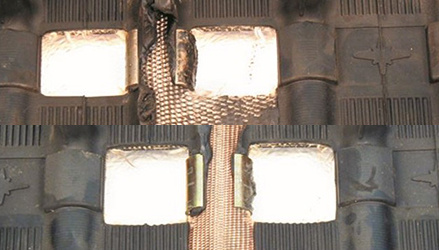
Description: Track lugs missing or section of rubber on track exposing webbing and rods.
Causes: Track is run at high speeds over long distances or extended periods of time. Lack of lubrication or cooling on slides and clips.
Recommendations: Avoid running in conditions with minimal snow or hard surfaces for extended periods of time.
Deep Snow Damage
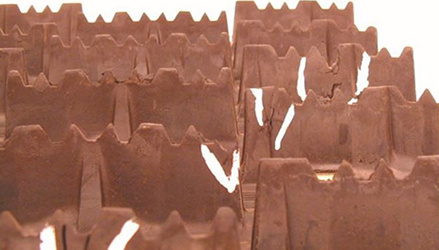
Description: Cut, torn, damaged or missing track lug.
Cause: Track damaged by spinning on rocks, stumps or other hard objects.
Recommendations: Avoid spinning your track on low or no-snow conditions. Do not run at high speeds over long distances or extended periods of time. This is especially important in conditions with minimal cooling and lubrication or when operating a track with a 1-inch or higher profile.
External Lug Damage
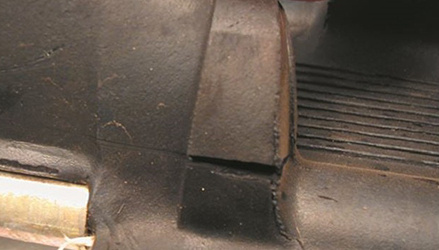
Description: Tear on the lug caused by a sharp object or prolonged bending of the lug.
Cause: Track spinning on gravel, pavement, ice or hard surfaces. Track damaged by rocks, stumps or hard objects.
Recommendations: Avoid spinning your track on low or no-snow conditions. Do not run at high speeds over long distances or extended periods of time. This is especially important in conditions with minimal cooling and lubrication or when operating a track with a 1-inch or higher profile.
Note: The provided information is a general guideline. Safety and maintenance information specific to your vehicle can be found in your Owner's Manual. Polaris owners can access Owner’s Manuals by logging in to their RideReady account.
Does your snowmobile need repair or maintenance? Find a RideReady dealer near you or schedule an appointment online.




